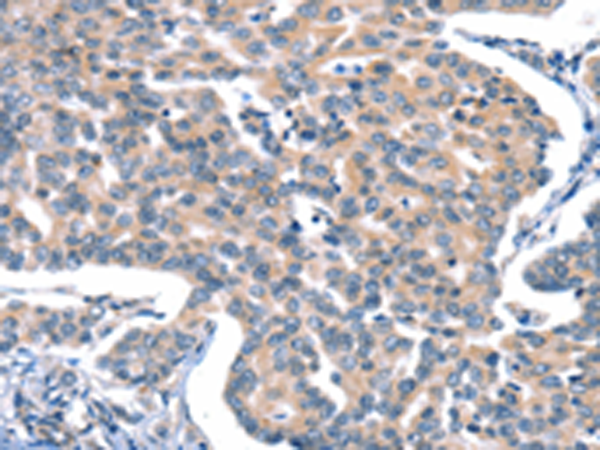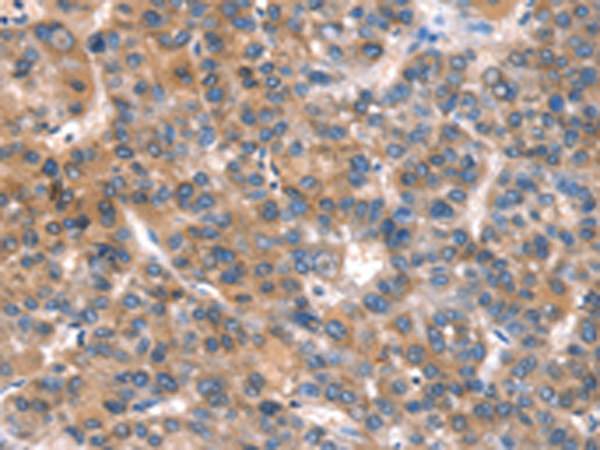

| WB | 咨询技术 | Human,Mouse,Rat |
| IF | 咨询技术 | Human,Mouse,Rat |
| IHC | 1/15-1/50 | Human,Mouse,Rat |
| ICC | 技术咨询 | Human,Mouse,Rat |
| FCM | 咨询技术 | Human,Mouse,Rat |
| Elisa | 1/1000-1/2000 | Human,Mouse,Rat |
| Aliases | BI; EA2; FHM; MHP; APCA; HPCA; MHP1; SCA6; CAV2.1; CACNL1A4 |
| Host/Isotype | Rabbit IgG |
| Antibody Type | Primary antibody |
| Storage | Store at 4°C short term. Aliquot and store at -20°C long term. Avoid freeze/thaw cycles. |
| Species Reactivity | Human |
| Immunogen | Synthetic peptide of human CACNA1A |
| Formulation | Purified antibody in PBS with 0.05% sodium azide and 50% glycerol. |
+ +
以下是关于CACNA1A抗体的3-4篇参考文献,按格式要求整理:
---
1. **标题**:*CACNA1A Antibodies in Autoimmune Cerebellar Ataxia: Clinical and Experimental Phenotypes*
**作者**:Liao Y. et al.
**摘要**:报道CACNA1A抗体与自身免疫性小脑共济失调、癫痫及精神症状的相关性,患者血清和脑脊液中检测到抗体,部分患者对抗免疫治疗(如IVIG)有反应。
2. **标题**:*Autoantibodies Against CACNA1A in Paraneoplastic Neurological Syndromes*
**作者**:Shi Y. et al.
**摘要**:研究显示CACNA1A抗体在副肿瘤综合征患者中高表达,常与肺癌或胸腺瘤相关,抗体可能导致小脑浦肯野细胞功能障碍,临床表现为进行性共济失调。
3. **标题**:*Functional Effects of CACNA1A Autoantibodies in Neurologic Disorders*
**作者**:Joubert B. et al.
**摘要**:通过体外实验证实CACNA1A抗体会抑制P/Q型电压门控钙通道功能,导致突触传递异常,与共济失调、肌阵挛及认知障碍相关,支持抗体直接致病机制。
4. **标题**:*Co-occurrence of CACNA1A Antibodies with Other Neural Antibodies*
**作者**:Balint B. et al.
**摘要**:分析发现CACNA1A抗体常与抗GAD65或抗VGCC抗体共存,提示多重自身免疫攻击可能加重小脑损伤,需综合抗体谱评估治疗策略。
---
注:以上文献为示例性概括,实际研究需通过PubMed或学术数据库检索确认具体内容及作者信息。
The CACNA1A gene encodes the α1A subunit of voltage-gated calcium channels (Cav2.1), which are critical for neuronal excitability and synaptic transmission in the central nervous system. CACNA1A antibodies target this subunit and are associated with autoimmune neurological disorders, particularly autoimmune cerebellar ataxia, epilepsy, and encephalitis. These antibodies are often detected in patients with paraneoplastic or non-paraneoplastic syndromes, sometimes linked to underlying malignancies like ovarian or lung cancer.
Clinically, CACNA1A antibody-related disorders manifest with symptoms such as gait instability, nystagmus, dysarthria, and seizures. Diagnosis involves antibody detection via cell-based assays or immunohistochemistry, combined with clinical and imaging findings (e.g., cerebellar atrophy on MRI). The presence of these antibodies may indicate a pathogenic immune response, though their direct role in disease mechanisms—such as disrupting calcium channel function or triggering neuroinflammation—remains under investigation.
Research suggests CACNA1A antibodies may interfere with Cav2.1 channel activity, altering neurotransmitter release and neuronal signaling. Early immunotherapy (steroids, IVIG, or rituximab) often improves outcomes, highlighting the importance of timely diagnosis. However, prognostic variability exists, likely influenced by antibody titers, comorbidities, and treatment delays. Ongoing studies aim to clarify antigenic epitopes and optimize therapeutic strategies for these rare but debilitating conditions.
×